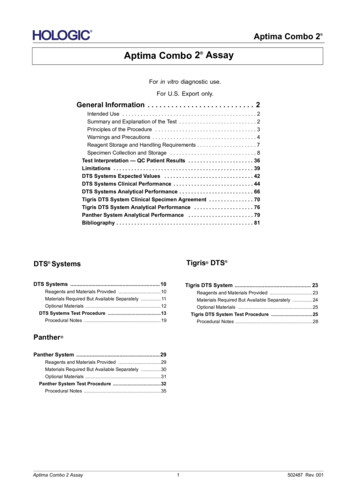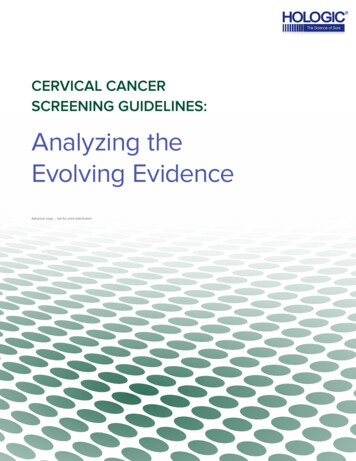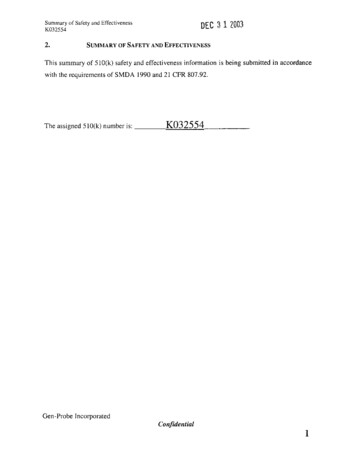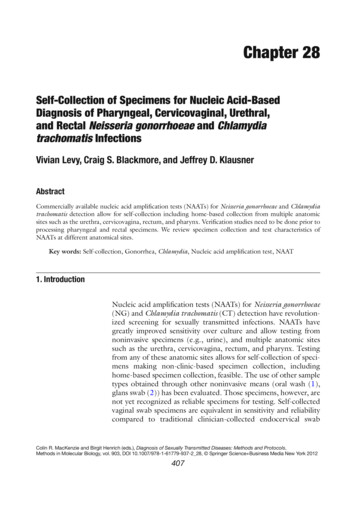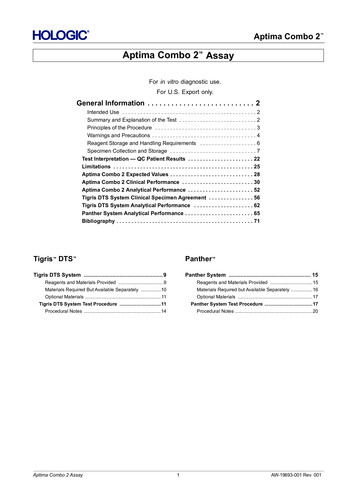
Transcription
Aptima Combo 2 Aptima Combo 2 AssayFor in vitro diagnostic use.For U.S. Export only.General Information . . . . . . . . . . . . . . . . . . . . . . . . . . . 2Intended Use . . . . . . . . . . . . . . . . . . . . . . . . . . . . . . . . . . . . . . . . . . . . . 2Summary and Explanation of the Test . . . . . . . . . . . . . . . . . . . . . . . . . . 2Principles of the Procedure . . . . . . . . . . . . . . . . . . . . . . . . . . . . . . . . . . 3Warnings and Precautions . . . . . . . . . . . . . . . . . . . . . . . . . . . . . . . . . . . 4Reagent Storage and Handling Requirements . . . . . . . . . . . . . . . . . . . 6Specimen Collection and Storage . . . . . . . . . . . . . . . . . . . . . . . . . . . . . 7Test Interpretation — QC Patient Results . . . . . . . . . . . . . . . . . . . . . . 22Limitations . . . . . . . . . . . . . . . . . . . . . . . . . . . . . . . . . . . . . . . . . . . . . . . 25Aptima Combo 2 Expected Values . . . . . . . . . . . . . . . . . . . . . . . . . . . . 28Aptima Combo 2 Clinical Performance . . . . . . . . . . . . . . . . . . . . . . . . 30Aptima Combo 2 Analytical Performance . . . . . . . . . . . . . . . . . . . . . . 52Tigris DTS System Clinical Specimen Agreement . . . . . . . . . . . . . . . 56Tigris DTS System Analytical Performance . . . . . . . . . . . . . . . . . . . . 62Panther System Analytical Performance . . . . . . . . . . . . . . . . . . . . . . . 65Bibliography . . . . . . . . . . . . . . . . . . . . . . . . . . . . . . . . . . . . . . . . . . . . . . 71Tigris DTS Panther Tigris DTS System .9Panther System . 15Reagents and Materials Provided .9Materials Required But Available Separately .10Optional Materials . 11Tigris DTS System Test Procedure .11Procedural Notes .14Reagents and Materials Provided .15Materials Required but Available Separately .16Optional Materials .17Panther System Test Procedure .17Procedural Notes .20Aptima Combo 2 Assay1AW-19693-001 Rev. 001
Aptima Combo 2 General InformationGeneral InformationIntended UseThe Aptima Combo 2 assay is a target amplification nucleic acid probe test that utilizestarget capture for the in vitro qualitative detection and differentiation of ribosomal RNA(rRNA) from Chlamydia trachomatis (CT) and/or Neisseria gonorrhoeae (GC) to aid in thediagnosis of chlamydial and/or gonococcal disease using the Tigris DTS system orPanther system, as specified. The assay may be used to test the following specimens fromboth symptomatic and asymptomatic individuals: clinician-collected endocervical, vaginal,male urethral, and both male and female throat and rectal swab specimens; patient-collectedvaginal, both male and female throat and rectal swab specimens1, and female and male urinespecimens. The assay is also intended for use with the testing of gynecological specimens,from both symptomatic and asymptomatic patients. These cervical specimens collected in thePreservCyt Solution vials may be tested either pre- or post-Pap processing. Testing of postPap processed specimens is limited to specimens processed with the ThinPrep 2000System and the ThinPrep 5000 System only.Patient-collected vaginal swab specimens are an option for screening women when a pelvic exam is nototherwise indicated. The Aptima Multitest Swab Specimen Collection Kit is not for home use.1Summary and Explanation of the TestChlamydia trachomatis (CT) and Neisseria gonorrhoeae (GC) infections are two of the mostcommon sexually transmitted infections worldwide. In the United States alone, a total of1,758,668 cases of CT infections (539.9 per 100,000 population) and 583,405 cases of GCinfections (179.1 per 100,000 population) were reported to the Centers for Disease Control in2018 (9).Chlamydiae are nonmotile, gram-negative, obligate intracellular bacteria. The CT species iscomprised of fifteen serovars (A, B, Ba, C, D, E, F, G, H, I, J, K, L1, L2 and L3) that cancause disease in humans (59). The serovars D through K are the major cause of genitalchlamydial infections in men and women (44). C. trachomatis can cause nongonococcalurethritis, epididymitis, proctitis, cervicitis, acute salpingitis, and Pelvic Inflammatory Disease(PID) (7, 24, 46, 47). C. trachomatis infections are often asymptomatic in both males andfemales. Children born to infected mothers are at significantly higher risk for inclusionconjunctivitis and chlamydial pneumonia (1, 17, 45).Historically, several methods for CT detection have been utilized in the clinical laboratory,including cell culture, direct fluorescent antibody testing, and enzyme immunoassay. Morerecent methodologies for CT detection include direct DNA probe assays and nucleic acidamplification test (NAAT) DNA probe assays. Cell culture was once considered to be the“gold standard” for detection of CT. Culture is quite specific, but scientific publications havedemonstrated that the NAAT DNA probe technologies have a higher clinical sensitivity thanculture (6, 14, 26, 50). Due to its lower clinical sensitivity and variable performance betweenlaboratories, culture has been replaced in many laboratories by direct DNA probe andNAATs.N. gonorrhoeae is the causative agent of gonorrheal disease. N. gonorrhoeae are non-motile,gram-negative diplococci. The majority of gonorrheal infections are uncomplicated lowergenital tract infections and may be asymptomatic. However, if left untreated in women,infections can ascend and cause PID. PID can manifest as endometritis, salpingitis, pelvicperitonitis, and tubo-ovarian abscesses. In men, gonorrhea may be complicated byepididymitis. In rare cases, this may lead to infertility (5). A smaller percentage of personswith gonococcal infections may develop Disseminated Gonococcal Infection (DGI) (23, 32).Aptima Combo 2 Assay2AW-19693-001 Rev. 001
Aptima Combo 2 General InformationConventional diagnosis of GC infection requires isolation of the organism on selective mediaor the observation of diplococci in Gram stained smears (25). Culture methods can havegood clinical sensitivity, but are highly dependent on proper specimen handling. Improperspecimen storage and transport can result in the loss of organism viability and yield falsenegative results. In addition, poor sampling technique, toxic sampling materials, and theinhibition of growth by components of body secretions can also result in false negativeresults (11, 28). Non-culture methods for GC detection include direct DNA probe tests andNAATs.First generation NAATs for CT and GC have technological issues that have limited theirperformance. These issues include cumbersome specimen processing and specimeninhibition that can yield false negative results (10, 15, 20, 30, 41, 51, 57, 58). The AptimaCombo 2 assay is a second generation NAAT that utilizes target capture, TranscriptionMediated Amplification (TMA), and Dual Kinetic Assay (DKA) technologies to streamlinespecimen processing, amplify target rRNA, and detect amplicon, respectively. Studiescomparing performance and specimen inhibition of various amplification systems havedemonstrated the benefits of target capture, TMA, and DKA technologies (12, 18). TheAptima Combo 2 assay qualitatively detects CT and/or GC rRNA in clinician-collectedendocervical, PreservCyt Solution liquid Pap specimens, vaginal, male urethral, and bothmale and female throat and rectal swab specimens; patient-collected vaginal, and both maleand female throat and rectal swab specimens, and female and male urine specimens fromsymptomatic and asymptomatic individuals.In 2019, novel C. trachomatis variants were discovered which contain point mutationsaffecting detection by the original version of the Aptima Combo 2 assay (22, 27, 42, 43, 55,56). Variant strains of chlamydia with mutations affecting diagnostic test performance havebeen reported previously (54) and are a natural product of microbial evolution. The updatedversion of the Aptima Combo 2 assay provides detection coverage for the variant strains ofC. trachomatis that emerged in 2019.Principles of the ProcedureThe Aptima Combo 2 assay combines the technologies of target capture, TMA, and DKA.Specimens are collected and transferred into their respective specimen transport tubes. Thetransport solutions in these tubes release the rRNA targets and protect them fromdegradation during storage. When the Aptima Combo 2 assay is performed in the laboratory,the target rRNA molecules are isolated from specimens by use of capture oligomers viatarget capture that utilizes magnetic microparticles. The capture oligomers contain sequencescomplementary to specific regions of the target molecules as well as a string ofdeoxyadenosine residues. A separate capture oligomer is used for each target. During thehybridization step, the sequence specific regions of the capture oligomers bind to specificregions of the target molecules. The capture oligomer:target complex is then captured out ofsolution by decreasing the temperature of the reaction to room temperature. Thistemperature reduction allows hybridization to occur between the deoxyadenosine region onthe capture oligomer and the poly-deoxythymidine molecules that are covalently attached tothe magnetic particles. The microparticles, including the captured target molecules bound tothem, are pulled to the side of the reaction vessel using magnets and the supernatant isaspirated. The particles are washed to remove residual specimen matrix that may containamplification reaction inhibitors. After the target capture steps are completed, the specimensare ready for amplification.Target amplification assays are based on the ability of complementary oligonucleotideprimers to specifically anneal and allow enzymatic amplification of the target nucleic acidstrands. The Aptima Combo 2 Assay replicates a specific region of the 23S rRNA from CTAptima Combo 2 Assay3AW-19693-001 Rev. 001
Aptima Combo 2 General Informationand a specific region of the 16S rRNA from GC via DNA intermediates. A unique set ofprimers is used for each target molecule. Detection of the rRNA amplification productsequences (amplicon) is achieved using nucleic acid hybridization. Single-strandedchemiluminescent DNA probes, which are complementary to a region of each targetamplicon, are labeled with different acridinium ester molecules. The labeled DNA probescombine with amplicon to form stable RNA:DNA hybrids. The Selection Reagentdifferentiates hybridized from unhybridized probe, eliminating the generation of signal fromunhybridized probe. During the detection step, light emitted from the labeled RNA:DNAhybrids is measured as photon signals in a luminometer, and are reported as Relative LightUnits (RLU). In DKA, differences in the kinetic profiles of the CT and GC labeled probesallow for the differentiation of signal; kinetic profiles are derived from measurements ofphoton output during the detection read time. The chemiluminescent detection reaction forCT signal has very rapid kinetics and has the “flasher” kinetic type. The chemiluminescentdetection reaction for GC signal is relatively slower and has the “glower” kinetic type. Assayresults are determined by a cut-off based on the total RLU and the kinetic curve type.Warnings and PrecautionsA. For in vitro diagnostic use.B. For professional use.C. For additional specific warnings, precautions and procedures to control contamination forthe Tigris DTS system, consult the Tigris DTS System Operator’s Manual.D. For additional specific warnings, precautions and procedures to control contamination forthe Panther system, consult the Panther System Operator’s Manual.Laboratory RelatedE. The assay was not evaluated in patient populations with a low prevalence of CT disease;therefore, performance in low prevalence settings has not been determined.F. Use only supplied or specified disposable laboratory ware.G. Use routine laboratory precautions. Do not eat, drink or smoke in designated work areas.Wear disposable, powderless gloves, protective eye wear, and laboratory coats whenhandling specimens and kit reagents. Wash hands thoroughly after handling specimensand kit reagents.H. Warning: Irritants and Corrosives: Avoid contact of Auto Detect 1 and Auto Detect 2with skin, eyes and mucous membranes. If these fluids come into contact with skin oreyes, wash with water. If spills of these fluids occur, dilute with water before wiping dry.I.Work surfaces, pipettes, and other equipment must be regularly decontaminated with2.5% to 3.5% (0.35 M to 0.5 M) sodium hypochlorite solution.Specimen RelatedJ. This assay has been tested using clinician-collected endocervical, PreservCyt Solutionliquid Pap specimens, vaginal, male urethral, and both male and female throat and rectalswab specimens; patient-collected vaginal, and both male and female throat and rectalswab specimens, and female and male urine specimens. Performance with specimensother than those specified under Specimen Collection and Storage has not been evaluated.Laboratories may validate other collection devices (33, 36).Aptima Combo 2 Assay4AW-19693-001 Rev. 001
Aptima Combo 2 General InformationGynecologic samples collected for preparation using the ThinPrep 2000 System orThinPrep 5000 System should be collected using broom-type or endocervical brush/plastic spatula combination collection devices.K. Expiration dates listed on the collection kits pertain to the collection site and not thetesting facility. Samples collected any time prior to the expiration date of the collection kit,and transported and stored in accordance with the package insert, are valid for testingeven if the expiration date on the collection tube has passed.L. The PreservCyt Solution has been validated as an alternative medium for testing withAptima Combo 2 assay. PreservCyt Solution liquid Pap specimens processed using theThinPrep 3000 Processor or other instruments have not been evaluated to test forChlamydia trachomatis and Neisseria gonorrhoeae using Aptima Combo 2 assay.M. After urine has been added in the urine transport tube, the liquid level must fall betweenthe two black indicator lines on the tube label. Otherwise, the specimen must be rejected.N. Maintain proper storage conditions during specimen shipping to ensure the integrity of thespecimen. Specimen stability under shipping conditions other than those recommendedhas not been evaluated.O. Specimens may be infectious. Use Universal Precautions when performing this assay.Proper handling and disposal methods should be established by the laboratory director.Only personnel adequately trained in handling infectious materials should be permitted toperform this diagnostic procedure.P. Avoid cross-contamination during the specimen handling steps. Specimens can containextremely high levels of organisms. Ensure that specimen containers do not contact oneanother, and discard used materials without passing over open containers. Changegloves if they come in contact with specimen.Q. If the lab receives a swab specimen transport tube with no swab, two swabs, a cleaningswab, or a swab not supplied by Hologic, the specimen must be rejected. Prior torejecting a swab transport tube with no swab, verify that it is not an Aptima SpecimenTransfer Tube as this specimen transport tube will not contain a swab.R. For PreservCyt Solution liquid Pap specimens, collect according to the manufacturer’sinstructions. Aliquots subsequently removed from the PreservCyt vial for testing by theAptima Combo 2 assay should be processed using only the Aptima Specimen Transfer Kit.S. Upon piercing, liquid can discharge from Aptima transport tube caps under certainconditions. Follow instructions in the appropriate Test Procedure to prevent this occurrence.Assay RelatedT. The performance of the Aptima Combo 2 assay has not been evaluated in adolescentsless than 14 years of age.U. Do not use this kit after its expiration date.V. Do not interchange, mix, or combine assay reagents from kits with different lotnumbers. Aptima controls and assay fluids can be from different lot numbers.Aptima Combo 2 Assay5AW-19693-001 Rev. 001
Aptima Combo 2 General InformationAptima Oil ReagentPolydimethylsiloxane 100%WARNINGH315 - Causes skin irritationH319 - Causes serious eye irritationSelection ReagentBoric Acid 1-5%Sodium Hydroxide 1%WARNINGH315 - Causes skin irritationH319 - Causes serious eye irritationTarget Capture ReagentEDTA 1-5%H411 - Toxic to aquatic life with long lasting effectsP273 - Avoid release to the environmentP280 - Wear eye protection/ face protectionNote: Hazard Communication reflects the EU Safety Data Sheets (SDS) classifications. Forhazard communication information specific to your region, refer to the region specific SDS onthe Safety Data Sheet Library at www.hologicsds.com.Reagent Storage and Handling RequirementsA. The following reagents are stable when stored at 2 C to 8 C (refrigerated):Aptima Combo 2 Amplification ReagentAptima Combo 2 Enzyme ReagentAptima Combo 2 Probe ReagentAptima Combo 2 Target Capture Reagent BAPTIMA Positive Control, CT / Negative Control, GCAPTIMA Positive Control, GC / Negative Control, CTB. The following reagents are stable when stored at 2 C to 30 C:Aptima Combo 2 Amplification Reconstitution SolutionAptima Combo 2 Enzyme Reconstitution SolutionAptima Combo 2 Probe Reconstitution SolutionAptima Combo 2 Selection ReagentC. The following reagents are stable when stored at 15 C to 30 C (room temperature):Target Capture ReagentAptima Wash SolutionAptima Buffer for Deactivation FluidAptima Oil ReagentD. Working Target Capture Reagent (wTCR) is stable for 30 days when stored at 15 C to30 C. Do not refrigerate.E. After reconstitution, the Enzyme Reagent, Amplification Reagent, and Probe Reagent arestable for 30 days when stored at 2 C to 8 C.Aptima Combo 2 Assay6AW-19693-001 Rev. 001
Aptima Combo 2 General InformationF. Discard any unused reconstituted reagents and wTCR after 30 days or after the MasterLot expiration date passes, whichever comes first.G. Controls are stable until the date indicated on the vials.H. Reagents stored on-board the Tigris DTS system have 48 hours of on-board stability.I.Reagents stored on-board the Panther system have 72 hours of on-board stability.J. The Probe Reagent and Reconstituted Probe Reagent are photosensitive. Store thereagents protected from light. The specified reconstituted stability is based on 12 hoursexposure of the Reconstituted Probe Reagent to two 60W fluorescent bulbs, at adistance of 17 inches (43 cm), and temperature less than 30 C. Light exposure of theReconstituted Probe Reagent should be limited accordingly.K. Upon warming to room temperature, some control tubes may appear cloudy or containprecipitates. Cloudiness or precipitation associated with controls does not affect controlperformance. The controls may be used whether they are clear or cloudy/precipitated. Ifclear controls are desired, solubilization may be expedited by incubating them at theupper end of the room temperature range (15 C to 30 C).L. Do not freeze the reagents.Specimen Collection and StorageThe Aptima Combo 2 Assay is designed to detect the presence of CT and GC in thefollowing specimens: clinician-collected endocervical, PreservCyt Solution liquid Papspecimens, vaginal, male urethral, and both male and female throat and rectal swabspecimens; patient-collected vaginal, and both male and female throat and rectal swabspecimens, and female and male urine specimens. Performance with specimens other thanthose collected with the following specimen collection kits has not been evaluated: Aptima Unisex Swab Specimen Collection Kit for Endocervical and Male Urethral SwabSpecimens Aptima Urine Collection Kit for Male and Female Urine Specimens Aptima Multitest Swab Specimen Collection Kit Aptima Specimen Transfer Kit (for use with gynecologic samples collected in PreservCytSolution)A. Instructions for collection:Refer to the appropriate specimen collection kit package insert for collection instructions.B. Specimen transport and storage before testing:1. Swab specimens:a. After collection, transport and store the swab in the swab specimen transport tube at2 C to 30 C until tested. Specimens must be assayed with the Aptima Combo 2Assay within 60 days of collection. If longer storage is needed, freeze at -20 C to-70 C for up to 12 months after collection (see Specimen Stability Studies).2. Urine specimens:a. Urine samples that are still in the primary collection container must be transported tothe lab at 2 C to 30 C. Transfer the urine sample into the Aptima urine specimentransport tube within 24 hours of collection. Store at 2 C to 30 C and test within 30days of collection.Aptima Combo 2 Assay7AW-19693-001 Rev. 001
Aptima Combo 2 General Informationb. After collection, transport the processed urine specimens in the Aptima urinespecimen transport tube at 2 C to 30 C and store at 2 C to 30 C until tested.Processed urine specimens should be assayed with the Aptima Combo 2 Assaywithin 30 days of collection. If longer storage is needed, freeze at -20 C to -70 C forup to 12 months after collection (see Specimen Stability Studies).3. PreservCyt Solution liquid Pap specimens:a. PreservCyt Solution liquid Pap specimens intended for CT and/or GC testing must beprocessed for cytology and/or transferred to an Aptima Specimen Transfer tubewithin 30 days of collection when stored at 2 C to 30 C (see Specimen StabilityStudies).b. If the ThinPrep Aliquot Removal procedure will be used, refer to the ThinPrep 2000,ThinPrep 3000, or ThinPrep 5000 Processor Operator’s Manual—Addendum forinstructions on aliquot removal. Transfer 1 mL of the removed aliquot into an AptimaSpecimen Transfer tube according to the instructions in the Aptima SpecimenTransfer Kit package insert.c. If testing the specimen after processing using the ThinPrep 2000 processor, processthe PreservCyt Solution liquid Pap specimen in accordance with the ThinPrep 2000Processor Operator's Manual and the Aptima Specimen Transfer Kit package insert.If testing the specimen after using the ThinPrep 5000 processor, process thePreservCyt Solution liquid Pap specimen in accordance with the ThinPrep 5000Processor Operator’s Manual and the Aptima Specimen Transfer Kit package insert.Transfer 1 mL of the fluid remaining in PreservCyt Solution vial into an AptimaSpecimen Transfer tube according to the instructions in the Aptima SpecimenTransfer Kit package insert.d. Once the PreservCyt Solution liquid Pap specimen is transferred to the AptimaSpecimen Transfer tube, the specimen must be assayed with the Aptima Combo 2assay within 30 days when stored at 2 C to 8 C or 14 days when stored at 15 C to30 C. If longer storage is needed, freeze at -20 C to -70 C for up to 12 months aftertransfer (see Specimen Stability Studies).C. Specimen storage after testing:1. Specimens that have been assayed must be stored upright in a rack.2. The specimen transport tubes should be covered with a new, clean plastic film or foilbarrier.3. If assayed samples need to be frozen or shipped, remove penetrable cap and placenew non-penetrable caps on the specimen transport tubes. If specimens need to beshipped for testing at another facility, recommended temperatures must be maintained.Prior to uncapping previously tested and recapped samples, specimen transport tubesmust be centrifuged for 5 minutes at 420 Relative Centrifugal Force (RCF) to bring all ofthe liquid down to the bottom of the tube. Avoid splashing and cross-contamination.Note: Specimens must be shipped in accordance with applicable national andinternational transportation regulations.Aptima Combo 2 Assay8AW-19693-001 Rev. 001
Aptima Combo 2 Tigris DTS SystemTigris DTS SystemReagents for the Aptima Combo 2 assay for CT and GC are listed below for the Tigris DTSsystem. Reagent Identification Symbols are also listed next to the reagent name.Reagents and Materials ProvidedAptima Combo 2 Assay Kit, 250 tests (2 boxes and 1 Controls kit) (Cat. No. PRD-05572and PRD-05572B)Aptima Combo 2 Refrigerated Box (Box 1 of 2)(store at 2 C to 8 C upon receipt)SymbolComponentQuantityAAptima Combo 2 Amplification ReagentNon-infectious nucleic acids dried in buffered solutioncontaining 5% bulking agent.1 vialEAptima Combo 2 Enzyme ReagentReverse transcriptase and RNA polymerase dried in HEPESbuffered solution containing 10% bulking reagent.1 vialPAptima Combo 2 Probe ReagentNon-infectious chemiluminescent DNA probes dried insuccinate buffered solution containing 5% detergent.1 vialTCR-BAptima Combo 2 Target Capture Reagent BNon-infectious nucleic acids in a buffered solution containing 5% detergent.1 x 0.61 mLAptima Combo 2 Room Temperature Box (Box 2 of 2)(store at 15 C to 30 C upon receipt)SymbolComponentQuantityARAptima Combo 2 Amplification Reconstitution SolutionAqueous solution containing preservatives.1 x 27.7 mLERAptima Combo 2 Enzyme Reconstitution SolutionHEPES buffered solution containing a surfactant and glycerol.1 x 11.1 mLPRAptima Combo 2 Probe Reconstitution SolutionSuccinate buffered solution containing 5% detergent.1 x 35.4 mLSAptima Combo 2 Selection Reagent600 mM borate buffered solution containing surfactant.1 x 108 mLAptima Combo 2 Target Capture ReagentBuffered salt solution containing solid phase and captureoligomers.1 x 54 mLTCRReconstitution Collars3Master Lot Barcode SheetAptima Combo 2 Assay1 sheet9AW-19693-001 Rev. 001
Aptima Combo 2 Tigris DTS SystemAptima Controls Kit(store at 2 C to 8 C upon receipt)SymbolComponentQuantityPCT/NGCAptima Positive Control, CT / Negative Control, GCNon-infectious CT nucleic acid in a buffered solutioncontaining 5% detergent. Each 400 µL sample contains theestimated rRNA equivalent of 1 CT IFU (5 fg/assay*).5 x 1.7 mLPGC/NCTAptima Positive Control, GC / Negative Control, CTNon-infectious GC nucleic acid in a buffered solutioncontaining 5% detergent. Each 400 µL sample contains theestimated rRNA equivalent of 50 GC cells (250 fg/assay*).5 x 1.7 mL*The rRNA equivalents were calculated based on the genome size and estimated DNA:RNA ratio/cell ofeach organism.Materials Required But Available SeparatelyNote: Materials available from Hologic have catalog numbers listed, unless otherwise specified.Cat. No.Tigris DTS System105118Aptima Assay Fluids Kit302382(Aptima Wash Solution, Aptima Buffer for Deactivation Fluid, and Aptima OilReagent)Aptima Auto Detect Kit301048Aptima System Fluid Preservative Kit302380Tips, 1000 µL conductive, liquid sensing10612513 (Tecan)Tigris DTS System Run Kit containing301191Multi-tube Units (MTU)MTU-Tiplet Waste Bag KitMTU Waste DeflectorsMTU Waste Covers104772-02900907900931105523301154CAptima Specimen Transfer Kitfor use with specimens in PreservCyt SolutionAptima Specimen Transfer Kit — printablePRD-05110for use with specimens in PreservCyt SolutionAptima Multitest Swab Specimen Collection KitPRD-03546Aptima Unisex Swab Specimen Collection Kit for Endocervical and 301041Male Urethral Swab SpecimensAptima Urine Specimen Collection Kit for Male and Female UrineSpecimens301040Aptima Urine Specimen Transport Tubes for Male and FemaleUrine Specimens105575Bleach, 5% to 7% (0.7 M to 1.0 M) sodium hypochlorite solution—Water for the Tigris DTS System—consult the Tigris DTS System Operator’s Manual for specificationsAptima Combo 2 Assay10AW-19693-001 Rev. 001
Aptima Combo 2 Tigris DTS SystemCat. No.Disposable gloves—SysCheck calibration standard301078Aptima penetrable caps105668Replacement non-penetrable caps103036AReplacement caps for the 250-test kits—Amplification and Probe reagent reconstitution solutionsEnzyme Reagent reconstitution solutionTCR and Selection reagentCL0041 (100 caps)501616 (100 caps)CL0040 (100 caps)Optional MaterialsCat. No.Aptima Controls Kit301110Hologic Bleach Enhancer for Cleaning302101for routine cleaning of surfaces and equipmentTigris DTS System Test ProcedureNote: See the Tigris DTS System Operator’s Manual for additional Tigris DTS systemprocedural information.A. Work Area Preparation1. Clean work surfaces where reagents and samples will be prepared. Wipe down worksurfaces with 2.5% to 3.5% (0.35 M to 0.5 M) sodium hypochlorite solution. Allow thesodium hypochlorite solution to contact surfaces for at least 1 minute and then followwith a water rinse. Do not allow the sodium hypochlorite solution to dry. Cover the benchsurface on which the reagents and samples will be prepared with clean, plastic-backedabsorbent laboratory bench covers.B. Reagent Reconstitution/Preparation of a New KitNote: Reagent reconstitution should be performed prior to beginning any work on theTigris DTS system.1. To reconstitute Amplification, Enzyme, and Probe Reagents, combine the bottles oflyophilized reagent with the reconstitution solution. If refrigerated, allow thereconstitution solutions to reach room temperature before use.a. Pair each reconstitution solution with its lyophilized reagent. Ensure that thereconstitution solution and lyophilized reagent have matching label colors beforeattaching the reconstitution collar.b. Check the lot numbers on the Master Lot Barcode Sheet to ensure that theappropriate reagents are paired.c. Open the lyophilized reagent vial and firmly insert the notched end of thereconstitution collar into the vial opening (Figure 1, Step 1).d. Open the matching reconstitution solution bottle, and set the cap on a clean,covered work surface.e. While holding the reconstitution solution bottle on the bench, firmly insert the otherend of the reconstitution collar into the
Aptima Combo 2 Aptima Combo 2 . and transported and stored in accordance with the package insert, are valid for testing even if the expiration date on the collection tube has passed. L. The PreservCyt Solution has been validated as an alternative medium for testing with Aptima Combo 2 assay. PreservCyt Solution liquid Pap specimens .
